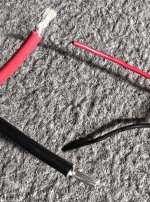If you already have power to the helm station it may be more than adequate for the Hummingbird and thus no reason to run more power & ground wires. As Dingbat highlights this unit draws a very small current (less than 1 Amp). Assuming you do not already have power to the front of the boat to take advantage of, the recommendation you got about running a 10AWG wire is probably based on minimizing voltage drop perhaps without doing the math. To provide a perspective, 10AWG wire is capable of about 40 amps.
The size of a wire to a load is dependent on two basic factors: the current draw and the distance. The higher the current draw and/or longer the length of wire, the heavier gauge wire needed. Fortunately, there are a ton of wire sizing calculators on the web. Here is a good one
link. Using that and inputting 12V, 1Amp and length of conductor (remember to use there and back, i.e. both Pos and Gnd) (I used 30 feet, so 15 feet from battery to device) and got 18AWG, a much lighter (smaller) gauge then 10AWG.
Other considerations:
- Tying directly to the battery is not a good idea, should feed off the battery disconnect switch.
- Fusing is about protecting the wire so good to have the run to the bow fused as close to the power source as possible as you are already expecting to do. What size fuse? Again web can be helpful. Here is a good link.
- If you do desire to run a heavy gauge wire to the bow, the strong suggestions of putting in a bus bar / fuse block is the way to go. And then feed the Hummingbird (with an appropriate fuse) off of that. This way you have power up to the bow for future mods, like adding a VHF radio or a sound system. Here is an example of ‘busbars’ link.
- Best to use ‘marine grade wire’ > this is tin plated for corrosion resistance.




















